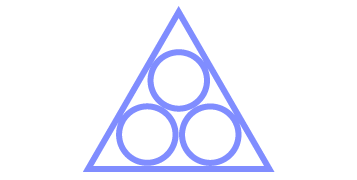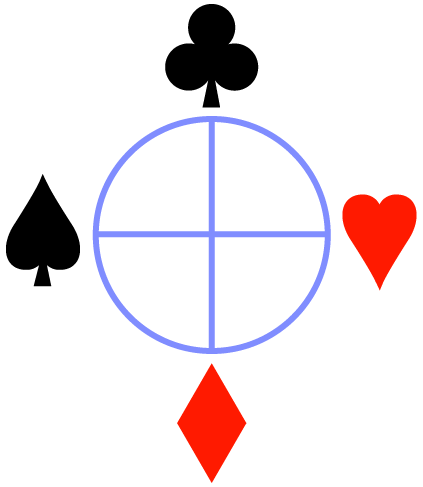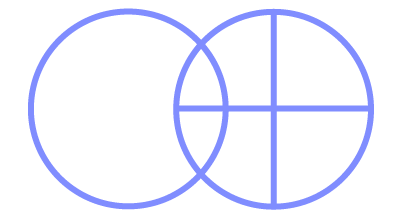
We live our lives like the centipede. He zips along so long as he doesn't think. If he had to decide which foot was next or, as Amie used to say, if he had to put his shoes on before leaving the house, he'd be stuck. He zips about because he think about other things, about food and safety and things we may guess but never know. We, on the other hand, ignore almost everything. In the process, the world seems like it came prepackaged, filled with everything anyone could ever want. Except us, of course. We represent the purpose of it all.
But the purpose of life, after food, clothing, shelter, good dinners, and bad habits, is to sometimes notice, wonder, ask, investigate, no matter what the consequences. If something stops us in our tracks, maybe that's where we belong.
Above is a familiar assortment of objects, though I suppose they're not really objects, only shapes. However, they do adorn familiar objects. It would be difficult to imagine anyone in this day and age who did not recognize them. Four symbols, red and black, on a field of white. Amie may still be putting her shoes on, but she would jump at the chance to tell you that red, black and white are the alchemical colors. So, there wasn't a long discussion the night before the first maker of standard cards scooped out gooey red ink to go with the standard black. Periwinkle and sage were never an option. Lavender, hot pink and raspberry were nowhere on the list. There was never anything in the works besides red, black and white. Of this we may be confident.
But, not certain. No one knows who that fictitious conversation the night before might have been between, because no one knows who designed them in the first place. They simply began to exist. We hear a great deal about masonic guilds, but never much about card makers guilds. Of course, most of us never stop to wonder. But this post isn't about card makers themselves, as interesting as that topic might be, but rather about the shapes they passed on to us.
Twenty years ago I was killing time playing solitaire with real cards the way they did in the olden days. It struck me that spades and hearts were almost the same. The spades had a foot to tell which way was down and were black instead of red. I'm sure I noticed that a thousand times before without pursuing it. But this particular day I was feeling invincible, not at solitaire, which is a stupid game — the results are decided in advance, so long as you remember to do things right. There's a large but finite number of games possible. Once you have cut the cards, your fate is basically sealed. Black Queen on red King… and so forth. I was feeling invincible in the sense that there was nothing I could not solve if I put my mind to it. I'm putting my mind to that same problem today without having completely solved it.
The problem is, what do these shapes mean, how did they come about, how do they relate to each other? I suppose we should call that a multiple question. It turns out that the questions themselves are multiple choice with none being absolutely right.

So, here's where we'll start. There's a V that appears several times, and some circles. Just so you'll know, I'm not going to discuss the feet, the little support under the spades and the clubs, sometimes called a stalk. I may be wrong, but I think they just tell us which way is down. I'm not sure they're supports either. The hearts and diamonds seem to rest on one point, while the spades and clubs could quite easily stand without help. So, maybe it's just a flourish. Something to keep things interesting. Leave it at that. The V appears as the bottom of the heart and as the top of the spade. It also appears twice on the diamond. In fact, the diamond is nothing else.
Here's where my invincibility came in handy. The three circles that form the clubs also appear in the hearts and spades. The top rounded portion of the heart, which you probably thought had something to do with the aorta, seems like it might have circles underneath. The V I've depicted is actually two sides of an equilateral triangle. If we complete the triangle in our imagination and place the center points of two circles on that imaginary line, we end up with something like the following.

You're probably ahead of me. With a little artistry, we can start from between the two circles, go up and over before gradually connecting with the V. Clicking another button or two, we end up with two symmetrical sides.

You know, hearts are like squiggled stars. No two are alike. Mine is far more perfect than I deserve. If I sketched this one on a Valentine — note the capital V in Valentine — you might say it was too elongated. Look, however, at the heart from a deck of Hoyle playing cards above. They're almost identical, except mine is orange and somewhat less precise. If I'm not mistaken, this is the basis for the heart: two circles, two sides of an equilateral triangle and a contoured line. Of course, the spade is a heart turned upside down.
I further realized that if the heart is part of the lower half of a diamond, then the spade is part of the other half, the upper half.

If that's the case, then the three fit together like parts of a puzzle. If you're clever you'll see a lemniscate, the symbol for infinity.

The three circles also snuggle up nicely inside an equilateral triangle — remember, there are two triangles in each diamond so, who knows, maybe the clubs are double thick.

The unpleasant truth of this process is that the club is too small and the diamond far too large. So, this isn't a method for placing the shapes on the cards, only a method for generating the shapes themselves. What we learn, we must learn from the shapes.

The people at Hoyle are not likely to feel threatened by my artistry, but I've given my clubs and spades feet, despite saying I wouldn't bother with them, and I think the likeness is somewhat striking. Here's what I've learned. The hearts and spades are alike but different. The diamonds and clubs are different. In a sense, diamonds and clubs are opposites, hearts and spades relatives. Diamonds represent fourness, clubs triplicity. Threes and fours have always been at odds. Hearts and spades represent something that goes up and down, one way and then the other. To keep things simple, something up followed by something down. My invincibility at once led me to the seasons.
There are two seasons that are alike but different — the equinoxes. One rises toward summer, the other falls toward winter. It made perfect sense to me that the spade should represent springtime. I won't quibble about word derivations here, but when do we turn the soil in anticipation of planting? And if the spade turns the soil and also drives upward like a shoot, the heart drives downward into the soil like a spike, turned over to become a cup. The heart is full and heavy with all that must now return. Which leaves summer and winter.
Through the years, I have waivered on which was which. My current view is that clubs represent summer. Returning to the discussion of Persephone and the Wheel of Fortune, or the Wheel of the Year, there are really three seasons above and one below. Each of the equinoctial seasons has a part in winter. One rises from it, putting on life as it does. The other descends into it clutching to life. Winter itself is neither dying nor growth, but death. My first theory was that hearts and spades fit nicely into diamonds, therefore they represent a triplicity of interlocking seasons. The club, having three parts, was a summation of the three. It made sense. It still makes sense. The three circles of the club are the three seasons inherent, we might say seed like, in winter. The diamond is in the crown of summer where it sparkles like victory.
Later on I found the passage in Numbers, prompted by several esoteric writers, that describes how the Levites were chosen for the priesthood — an important passage. A rod was gathered from all the tribes of Israel. Among them, from the tribe of Levi, was the rod of Aaron. They were placed in the tabernacle over night. "And it came to pass, that on the morrow Moses went into the tabernacle of witness; and, behold, the rod of Aaron for the house of Levi was budded, and brought forth buds, and bloomed blossoms, and yielded almonds." As a result, the tribe of Levi became the tribe nearest to god, the priestly tribe. If we combine the symbolism of Numbers with our discussion of the seasons, several things become clear. A club is not merely a cudgel in this case. A rod is a staff, it is also a baton. Furthermore, it is a club. The suit club, however, looks nothing like a rod. It has become the fruit that buds and blooms and pours forth from the rod. There is nothing club like or rod like in three circles. While I suggest they represent the three seasons, they actually represent the apotheosis of them, the height of the annual cycle when the growth is so lush that dead wood itself seems to put forth fruit.
Which leaves diamonds. Is it any wonder that thieves call diamonds ice? We think of diamonds as glittery bits and bling. Ask the seven dwarves. Diamonds come from deep within the earth, the dark realm of Persephone — who seems never far from our thoughts. I thought at first that clubs summed up the other three. Now, it seems clear they preside over two and are themselves the third. Maybe those stems or stalks or feet seem less decorative now. Diamonds represent a totality of four. Think of them as the seeds that contain everything. They represent life, death, birth, and everything in between. They are the crystalline synthesis of our vast and tiny world.



